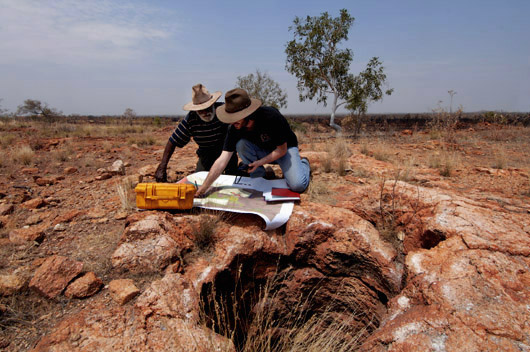A.bc
In Australia, sulle tracce di Chatwin 20 anni dopo Le Vie dei Canti
Palazzo delle Esposizioni, Roma
A.bc
In Australia, in Chatwin's footsteps 20 years after The Songlines Palazzo
Delle Esposizioni, Rome


Nelle
“Vie dei Canti” il personaggio principale, interlocutore dell’io
narrante, si chiama Arkady Volchok. Australiano di origine russa, trentatreenne,
aiuta gli aborigeni identificando i proprietari tradizionali della terra
e facendosi raccontare i luoghi legati al Tempo del Sogno, quando gli
antenati col loro canto crearono il mondo. Traduce la legge tribale nel
linguaggio moderno dello stato per evitare, in particolare, che la linea
ferroviaria in costruzione tra Alice e Darwin violi l’opera degli
eroi della Creazione. Di passaggio a Tennant Creek, sembra d’incontrare
un Arkady contemporaneo, vent’anni dopo. Alberto Furlan, laureato
in Antropologia a Venezia e con un PhD in studi aborigeni all’Università
di Sydney, 32 anni, lavora da un anno e mezzo per il Central Land Council
della città mappando con il GPS i luoghi sacri agli aborigeni dell’area
intorno. Ascolta, registra, media. Rappresenta i loro interessi nei rapporti
con le compagnie minerarie, soprattutto. Sia per evitare che i siti sacri
vengano coinvolti nelle attività estrattive, sia per far riconoscere
adeguati diritti economici (acquisto concessioni, percentuale sui ricavati)
ai legittimi proprietari della terra. Day Day, 73 anni, mandriano aborigeno,
memoria vivente dei siti sacri e del loro significato, gli mostra nel
bush vicino a Three Ways il luogo dove nel tempo della creazione due esseri
ancestrali femminili scavarono la roccia per dissetarsi. Il pozzo è
ancora lì, tra spinifex inceneriti dall’ultimo incendio ed
eucalipti onnipresenti, a volte ancora sfruttato, come testimonia il filo
di ferro usato per tirar su i secchi d’acqua lasciato lì
di fianco
The
name of the main character of The Songlines, interlocutor of the first
person narrator, is Arkady Volchok. A thirty-three-year-old Australian
of Russian origins, he helps the Aborigines by identifying the traditional
landowners and making people tell him about the places linked to the Dreamtime,
when the ancestors created the world with their songs. He translates the
tribal law in the modern language of the State in order to prevent, in
particular, the railway under construction between Alice and Darwin from
violating the work of the heroes of the Creation. Travelling through Tennant
Creek you get the impression of meeting a contemporary Arkady, twenty
years later. Alberto Furlan, thirty-two years old, a degree in anthropology
in Venice and a PhD in Aboriginal studies at Sidney University, has been
working for one and a half year for the Central Land Council of the city,
mapping by means of a GPS the places sacred to the Aborigines of the surrounding
area. He listens, records, mediates. He represents their interests in
the relations with the mining companies in particular. Not to let the
sacred sites be involved in the extractive activities and, at the same
time, to make the legitimate landowners obtain their economic rights (purchase
of concessions, percentage on profits). Day Day, a 73 years old Aboriginal
herdsman, living memory of the holy sites and their meaning, shows Alberto
the place in the bush near Three Ways where, at the time of the creation,
two female ancestors dug a hole in the rock to quench their thirst. The
well is still there, between spinifex burnt down by the last fire and
omnipresent eucalypts, sometimes still in use, as the wire to pull up
the buckets of water left by its side